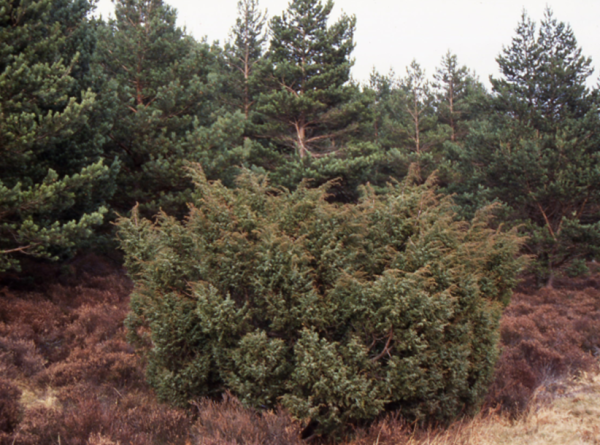Juniper
Download a pdf copy of this Practical Guide
Action Points
Common juniper is a sprawling, evergreen shrub that tends to grow in colonies. It is a spiny bush, the blue-green leaves forming needles. On female plants, the green flowers ripen to blackish-blue berries.
- Prevent too much grazing causing bushes to decline, or too little grazing causing bushes to become over shaded.
- Don’t clear Juniper
- Prevent muirburn
- Avoid fragmentation of bushes or no viable seed will be produced
Habitat Requirements
Juniper has three sub species, two of which grow in Scotland: the upright type which is a shrub or small tree (height up to 5m) (Juniperus communis ssp. communis), and the prostrate or dwarf type (Juniperus communis ssp. nana). Both have separate male and female bushes.
Juniper is unusual as it grows in a wide range of habitats, from moorland and maritime heaths to woodlands and montane environments from sea level to 1000m altitude. Upright Juniper grows frequently in open pine and birch woods and it is also a minor component of upland oakwoods. Prostrate Juniper grows in exposed habitats from coast to treeline often as part of a heath community.

Management Requirements to Benefit Juniper
- The ideal management for Juniper sites is light grazing: take into account the effect of deer and rabbits as well as livestock. Voles can be a problem for young plants.
- Some grazing helps prevent shading of the plants but usually means the juniper doesn’t get browsed as it’s never a preferred food plant.
- Many juniper areas across Scotland occur in populations of less than 10 plants, a viable population should contain more than 50 plants in scattered stands less than 500m apart.


- Due to the fact that Juniper has separate male and female bushes, they cannot produce viable seed if the bushes become isolated and need a good mix of male and female bushes to successfully reproduce.
- Juniper doesn’t like waterlogging especially during the winter when long term water logging can kill plants. Well drained soils are best.
- Juniper can grow in nutrient poor soils which can be either acid such as heaths or alkaline on more calcareous soils

Juniper Facts
- The commonest use of juniper berries is to flavour gin and in medieval times the berries were also used to flavour whisky.
- The berries were also used to aid digestion, cure tapeworm infestations and prevent flatulence.
- Juniper was burnt, not for it’s heat but for it’s aromatic smoke said also to cast out witches.
Sign up to the FAS newsletter
Receive updates on news, events and publications from Scotland’s Farm Advisory Service
